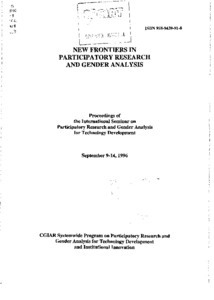Farmer participatory research: measuring impact
The major issues in impact assessment for farmer participatory research (FPR) are analyzed. There are many potential ways in which FPR can have an impact; for example, increasing agricultural productivity, improving the management of natural resources or leading to a wider dissemination of innovations. FPR may also be more effective in reaching specific target groups, and it many reduce research costs and develop community capacity. Impact will be measured by different groups, and for different reasons, according to the circumstances. When the time comes to carry out an impact study , the assessors face a number of decisions: What to measure? The impact chosen will depend on the motive for the evaluation. The evaluators will take into account the object of the FDR intervention and also their own intentions for the study. In a typical case applying FPR to increase productivity through technical change, initial outputs could include types of technology, which might encompass new varieties of germplasm, or methodologies for integrated pest management, crop management, or post-harvest. But the ultimate outputs would be the results of applying these improvements, manifested in increased yields, reduced production costs, greater stability, or improved sustainability. Types of impact to be measured may include enhanced diffusion, measured in terms of increased rapidity, spatial distribution, or diversity of users. It`s important to ascertain that the technologies are reaching the people who need them: especially those without other resources, women, ethnic groups, or people in marginal areas.

